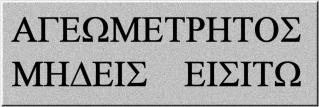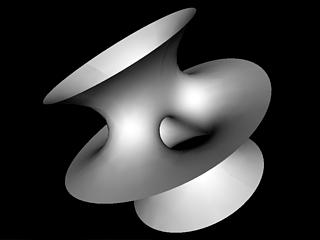Term 1, 2014/15



I will return the last assignment on Wednesday, December 3rd during the last lecture period (I will not be lecturing, but you can ask me questions). You can also pick it up during my office hours on Thursday.
Extended office hours before the Exam: Tuesday, December 9th : 2:00 to 5:00 pm Thursday, December 11th : 2:00 to 5:00 pm
Read my notes (and
my lips!)
Good Luck and Happy Holidays!
------------------------------------------------------------------------------------------------------------------------------------------------------------------------------
Assignment #5 was due on Wednesday, November 26th, 2014 (extended to Monday, December 1st!) Please hand it to me at the beginning of the lecture period.
Presentations:
Thursday. November 27th: Shuai Zhang: "Arbitrage as curvature"
Wednesday, November 26th: Stephanie Ciccone: "Flag Manifolds"
Monday, November 24th: Miles Couchman: "Classical Mechanics via differential forms"Wednesday, November 19th: Sean Ridout: "Chern classes"
Monday, November 17th: Darij Starko: "Dirac spinors and the Hopf fibration"
Thursday. November 13th: Lee
van Brussel: "Introduction to Morse Theory"
Wednesday, November 12th: Dillon Doherty: "Linking Numbers"
Presentations (30 to 40 minutes each) began on Wednesday,
November 12th.
Reports are due a week after the presentation
There was a short 20-minute quiz during the lecture period on Monday, November 10th
Assignment
#4 was due on Wednesday, November 5th, 2014.
Click here for a video about the circles in the Hopf fibration.
Click here for a paper explaining how and where the Hopf fibration shows up in modern theoretical physics.
Click
here for my introductory notes about calculus on
differential manifolds (which will be expanded,
revised and updated regularly during the term)These notes
cover the material of the first four weeks of the course.
Please read them carefully before you
come to the lectures
There will be a short 20-minute quiz during the lecture
period on Monday, October 27th (postponed to November 10th)
Assignment
#3 was due on Monday, October 20th, 2014.
There was a short 20-minute quiz during the lecture period
on Monday, September 29th.
Assignment #1 was due on
Monday, September 22nd, 2014. Please hand it to me at the
beginning of the lecture period.
Click here
for another beautiful lecture on 3-manifolds by a master
topologist, the late William Thurston.
If you are interested, click here
for a very "impressionistic" but deep lecture by Misha Gromov,
one of my "favourite" mathematicians.
Review of multivariable calculus, basic properties of manifolds, differential forms, Stokes' theorem, de Rham cohomology and applications.
Course Objective:This is a course, where students are expected to study some of the material on their own and also do a 20 minute presentation on a topic that is chosen with the instructor's approval.
Students are responsible for reading the relevant material from
the reference books, my notes and/or any other resources (freely
available on the internet) on their own (known as self-directed
inquiry-based blended experiential learning) in
preparation for the lectures.
There are no required
textbooks although I strongly recommend the students to get a
copy and read at least two of the following books regularly:
Other books:
Some interesting pages on the internet:
You are expected to exhibit honesty
and use ethical behaviour in all aspects of the learning
process. Academic credentials you earn are rooted in principles
of honesty and academic integrity. Academic dishonesty is to
knowingly act or fail to act in a way that results or could
result in unearned academic credit or advantage. This behaviour
can result in serious consequences, e.g. the grade of zero on an
assignment, loss of credit with a notation on the transcript
(notation reads: Grade of F assigned for academic dishonesty),
and/or suspension or expulsion from the university. It is your
responsibility to understand what constitutes academic
dishonesty. For information on the various types of academic
dishonesty please refer to the Academic Integrity Policy,
located at http://www.mcmaster.ca/academicintegrity
The following
illustrates only three forms of academic dishonesty:
1. Plagiarism,
e.g. the submission of work that is not one's own or for which
other credit has been obtained.
2. Improper
collaboration in group work.
3. Copying
or using unauthorized aids in tests and examinations.
Please check the following link for
MSAF policy:
http://academiccalendars.romcmaster.ca/content.php?catoid=7&navoid=559#Requests_for_Relief_for_Missed_Academic_Term_Work
When using the
MSAF, also report your absence to me (the course
instructor M. Min-Oo) within 2 working days by email
(minoo@mcmaster.ca) and contact me in person to
learn what relief may be granted for the work you
have missed, and relevant details such as revised
deadlines, or time and location of a make-up exam.
Please note that the MSAF may not be used for term
work worth 30% or more, nor can it be used for the
final examination.
Only
the standard McMaster calculator Casio fx 991 can be used
for the tests and the final examination.
Important
Notice:
The instructor and the university reserve the right to
modify or revise information contained in this course
during the term. The university may change the dates and
deadlines for any or all courses in extreme circumstances.
If either type of modification or revision becomes
necessary, reasonable notice and communication with the
students will be given with explanation and the
opportunity to comment on changes. It is the
responsibility of the student to check their McMaster
email and course websites weekly during the term and to
note any changes.
Week 0 (04/09
to 05/09): First lecture: Introduction
Week 2 (15/09
to 19/09): What is a differential manifold? What is a
vector bundle? What are vector fields? What is the Lie
derivative? Cartan's magic formula.
Week 4 (29/09
to 03/10): deRham cohomology,
Mayer-Vietoris sequence, Euler characteristic, Künneth
formula, cohomology with compact support, degree of a map,
winding numbers, linking numbers.
Week 9 (03/11
to 07/11): What is a connection? What is curvature?
Week 11 (17/11
to 21/11): Presentations
Week 13 (01/12 to 03/12):